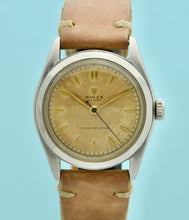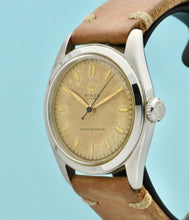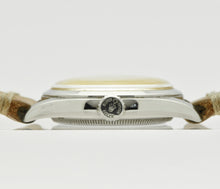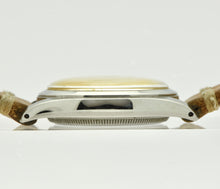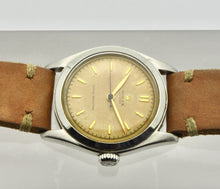
Manual-winding, stainless steel wristwatch, circa the 1950s.
Case: Stainless steel, polished bezel, plexiglass crystal. Signed crown.
Dial: Hours, minutes, sweep seconds, and date. Tropical, peach-tinged dial with gold indices. Signed.
Movement: Manual-winding, Rolex caliber.
Condition: Dial has developed a patina, timing within vintage specifications.
Diameter: 35mm, thickness: 11.5mm.
Serial: 784xxx.
Circa 1950s.
More about Rolex:
The Rolex Oyster, when it was released in 1926, was the world’s first water-resistant watch. Arguably, it changed the watch market forever, with a new focus on durability and water resistance.
In 1927, Mercedes Gleitze became the first Englishwoman to swim the English Channel. Later, also in 1927, Gleitze repeated the swim while wearing an early, gold Rolex Oyster around her neck. Following the swim, and because of increased media attention to Gleitze, Rolex partnered with the swimmer, using her notoriety and her likeness in the company’s official advertising, which continues to this day.
Since its debut, the Rolex Oyster has undergone many design changes. The present watch, the reference 6082 dates to the 1950s and features a warm, tropical dial and elegant, gold feuille hands.
In the late 1940s, Rolex introduced larger bubblebacks, including the early Datejust with a diameter of 36mm. They received the nickname of big bubblebacks, and later, the Italian nickname of "Ovettone" (a big egg from the Italian word uovo). Scholars consider only four references to be true “ovettone”: references 4467, 6031, 6074, and 6075.








